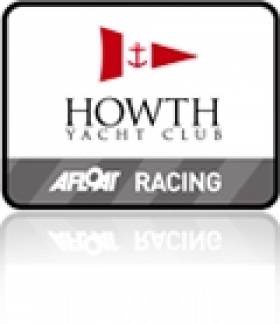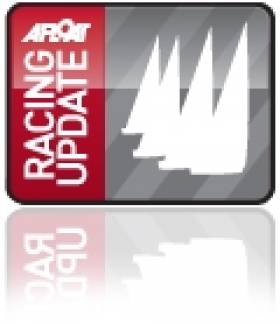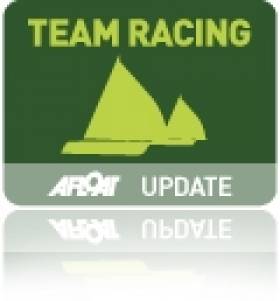Displaying items by tag: Howth Yacht Club
Ireland's Oldest Wooden Boats Aren't Getting Any Younger
#woodenboats – On Midsummer's Day, W M Nixon looks back on the already busy and event-filled Irish season of 2014, and reflects on the extraordinary longevity of some boats, their remarkable variety, and the diverse characters who own them.
When I shipped aboard the former Bristol Channel Pilot cutter Madcap to sail the Old Gaffers Division in Howth Yacht Club's Lambay Race on June 7th, it wasn't the first time I'd been out and about on a boat built in the 1870s. But as most of my experiences on John and Sandra Lefroy's 1873-vintage iron-built classic 58ft Victorian steam yacht Phoenix on Lough Derg took place in the 1970s with the most recent jaunt being way back in 1982, sailing on the Madcap was indeed the first time afloat in a boat built 140 years ago.
It takes an effort to get your head around the most basic notion of such an age. You find yourself reflecting on the delights that still awaited the human race at the time, things that were still far into the remote future in the 20th Century. During the 1870s, industrialisation was still gaining traction, but the very idea of warfare on the industrial scale which was to be experienced in the Great War of 1914-18 was beyond most people's imagination, and way beyond anyone's experience. That said, there were more than enough other ways of experiencing an early death, with a range of particularly unpleasant illnesses which have been largely eliminated today.
Yet it was increasing industrialisation which created the circumstances that enabled both boats to be built. The Bristol Channel Pilot cutters evolved rapidly in the latter half of the 19th Century in order to provide pilots for the more numerous and increasingly large ships which were coming into ports such as Cardiff and Bristol. They reached their peak of performance around 1900, by which time they'd achieved a remarkable stage of development, being fast and able, yet comfortable at sea, and capable of being handled by a very small crew after the pilots had been delivered to incoming vessels. When their working days were over as they were replaced by motorised vessels, they proved ideal as seagoing cruising yachts.
There was nothing work-oriented about the pleasure yacht Phoenix when she was built to the designs of Andrew Horn in Waterford in 1873. Or maybe that's being a bit naïve. After all, she is down as having been built by and for the Malcolmsons of Waterford. They were a remarkable clan who brought many industries to Waterford in the 19th Century, and they created the miniature industrial town of Portlaw westward from the city, off the south bank of the Suir Estuary.
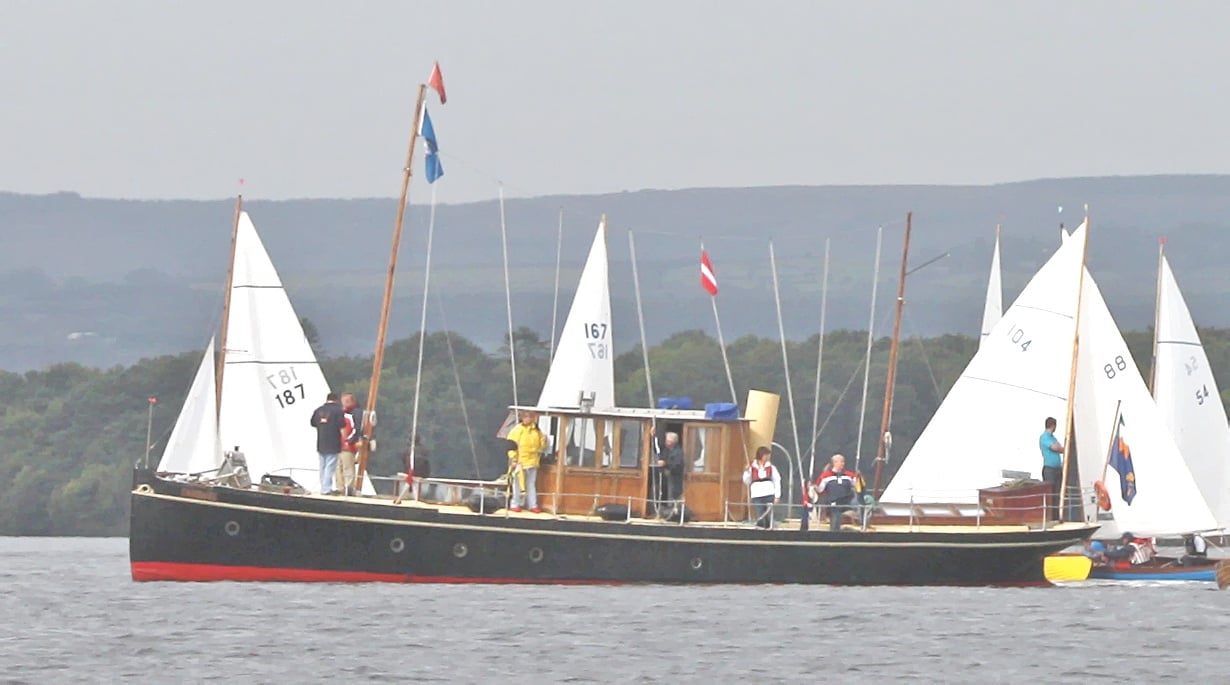
The 58ft Phoenix, iron-built in Waterford in 1873, performing Committee Boat duties at Dromineer for Lough Derg YC. Photo: Gerardine Wisdom
So in building the Phoenix themselves, so to speak, they were creating a subtle advertisement for Waterford expertise, with this new miniature of an ocean liner being constructed in the highly-regarded Lowmoor iron. And she's a powerful statement - this lovely old vessel has lasted much better than many of the Waterford enterprises which outshone her at the time of her building, so much so that if, in Waterford's current recessional woes, they sought something to symbolise what the city is capable of, they would do worse than put some resources the way of the Phoenix for her continuous maintenance.
Five years ago she made a very stylish appearance as the Committee Boat in a classics regatta at Dromineer, and that in turn produced an astonishing photo which included Ian Malcolm's 1898-built Howth 17 Aura. It was the first time a jackyard topsail had been seen on Lough Derg since before the Great War, and all that together with a raft of Shannon One Designs (which date from 1922 onwards) and a fleet of Dublin Bay Water Wags from 1902 onwards meant that the total age of the boat in the photo was pushing towards the 2,000 years mark.

Phoenix and the 1898 Howth 17 Aura (Ian Malcolm) at Dromineer with rafts of Shannon ODs and Water Wags. The combined age of the bots in the photo is well over a thousand years. Photo: Gerardine Wisdom
To be aboard Phoenix is to be transported right back to the 1870s, as she has a beam of only 10.5ft, which on a length of 58.5ft make for one very slim and potent hull. She has long since had her original steam engine replaced with a diesel, and back in 1982 when I was last afloat in her, it was October, and we were the Committee Boat for the annual IYA Helmsmans Championship, raced that year in Shannon One Designs with Dave Cummins of Sutton the winner, crewed by Gordon Maguire.
Being late season, the Phoenix's injectors needed a clean, but as the Race Officers were those perpetual schoolboys Jock Smith and Sam Dix of Malahide, they were delighted by the Phoenix's ability to emit a fine plume of smoke from her funnel at full speed, and after the championship was resolved they tore across the lively waters of Autumnal Lough Derg at full speed while – from another boat - I grabbed some photos which made Phoenix look like a destroyer in action at the Battle of Jutland. One of them subsequently appeared as the cover of Motor Boat & Yachting, and as I seem to have mislaid the colour slides, if anyone has a copy of that particular edition I'd much appreciate a scan of it.
Moving on from the 1873-built Phoenix in 1982 to the 1874-built Madcap in 2014 is quite some saga, but we'll edit it by sticking to events this year revolving around the developing annual Old Gaffer programme in the Irish Sea. Last year Dickie Gomes' 1912-built 36ft John B Kearney yawl Ainmara from Strangford Lough won the inaugural Leinster Trophy race in Dublin Bay which marked the OGA's Golden Jubilee, and she did it despite now being bermuda rigged. But as she was returning to her birthplace in Ringsend for the first time in 90 years, she was treated as an honorary gaffer.
Honour being the theme of things, this meant we were honour-bound to bring her south again to defend the Leinster in 2014, but this was given an added impetus by a plan to link up in Dun Laoghaire with Martin Birch's 1902-built Espanola out of Preston in Lancashire. From 1912 until 1940, the 47ft Espanola was a feature of the Royal Irish YC in Dun Laoghaire, owned by noted sailor Herbert Wright, who in 1929 became the founding Commodore of the Irish Cruising Club when he cruised Espanola with four other yachts to Glengarriff where the ICC was founded on July 13th 1929. The Espanola links, together with the fact that the RIYC is now in partnership with Wicklow Sailing Club in hosting the fleet for the biennial Round Ireland Race, made for a fortuitous combination, as Dickie Gomes of Ainmara was Mr Round Ireland between 1986 and 1993, when he held the open Round Ireland Record and also had been overall winner of the 1988 race.

Espanola as she was in 1929, when Commodore's yacht at the founding of the Irish Cruising Club
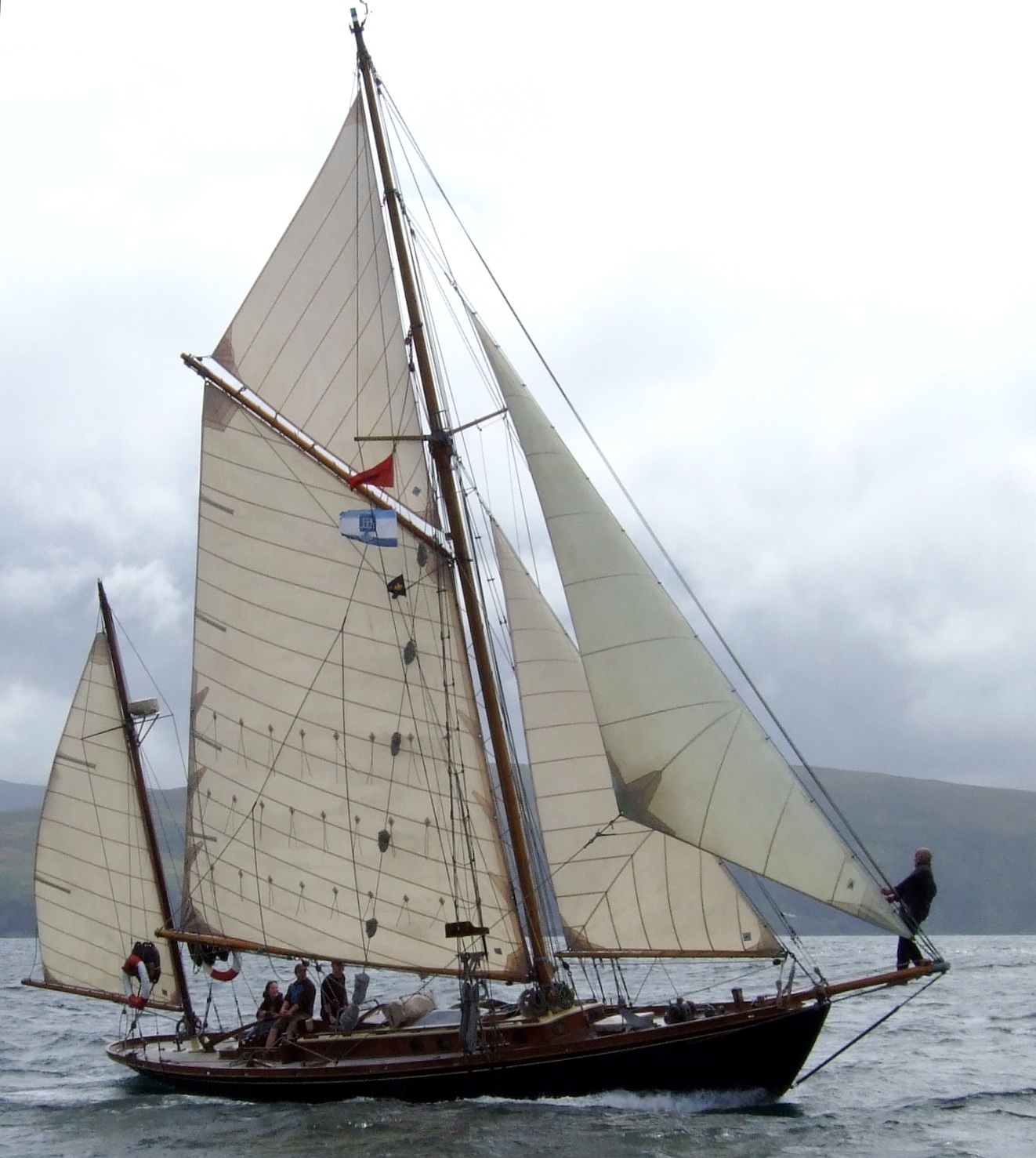
The 1902-built Espanola as she is today
Thus all the stars were in alignment for an historic and convivial meeting of the two old boats at the RIYC on the evening of Friday May 30th, the night before the Leinster Plate race was due to start just round the corner in Scotsmans Bay. But while stars may have been in alignment, ducks failed to get into a row, as Espanola with her exceptional draft of 7ft 6ins failed to get out of Preston over the shallow bar in the one tide which would have suited, on May 16th.
This situation is a useful illustration of the problems the old gaffer people face in keeping the show on the road with limited resources. Martin Birch, having been a lecturer in Lancaster University, had found Preston's little marina an ideal place to keep and maintain Espanola, and the marina in turn regarded the old girl as their pet boat. But Preston is longer a busy commercial port, so the channel has been left to is own devices, and with the huge tides of the Lancashire coast, getting Espanola to sea is quite a challenge as sometimes there's only one day in any month when it can be done.
So there we were, faced with the prospect of Hamlet without the Prince with just ten days to go to the historic gathering at the RIYC. But Jim Horan, affable Commodore of the Royal Irish YC, took it all in his stride and told us to bring Ainmara along anyway, it would be a good excuse for a Friday night party and he was keen to meet the skipper who had made the Round Ireland challenge very much his own 28 years ago.
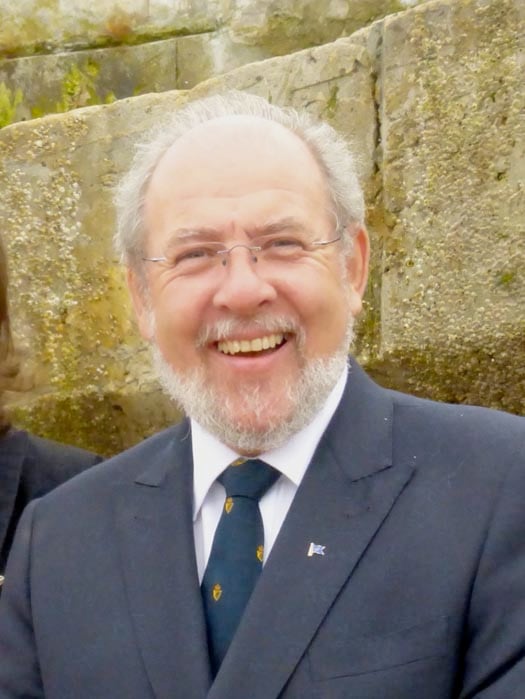
Jim Horan, Commodore of the RIYC, told us to come on and be welcome even though Espanola couldn't make it. Photo: W M Nixon
With the foul weather of mid-May, while Ainmara had got afloat from her winter quarters in a hayshed at the Gomes farm on the Ards peninsula in County Down, further fitting out was difficult in endless rain, and the skipper came down with a massive cold. But then the weather perked up, and he did too, so at lunchtime on Thursday My 29th we headed down Strangford Lough from the Down Cruising Club's former lightship headquarters at Ballydorn to catch the start of the ebb in Strangford Narrows at 1430 hrs.
Progress was good with a light to moderate nor'easter, but Ainmara and her crew (there were four of us – Brian Law, Ed Wheeler and I together with Dickie) have got to the stage where nights at sea are regarded to be the result of bad cruise planning. Yet if we were going to be comfortably in Dun Laoghaire for Friday evening, then only Port Oriel at Clogherhead made sense as an overnight. But Port Oriel, home to some of the best-maintained fishing boats on the coast, can become a very crowded place on a Thursday night.
However, a phone call to the uncrowned king of Clogherhead Aidan Sharkey – whom I'd first met back in the 1980s when our two boats were moored in Seal Hole at Lambay, where he was diving on the nearby 1854 wreck of the Tayleur - ensured there'd be a berth for us, and when we arrived in at sunset there was the man himself to direct us to a corner where we wouldn't inconvenience fishing boats, and moreover had access to a set of proper steps.
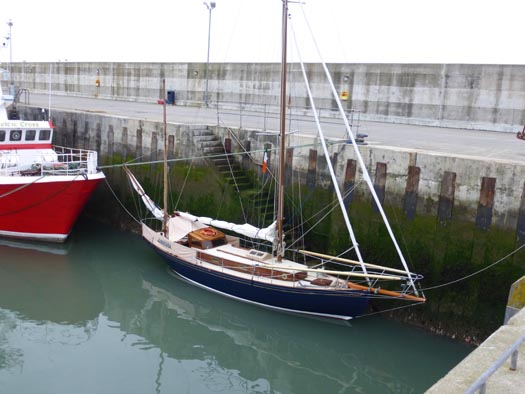
Port Oriel at Clogherhead provided Ainmara wih a handy overnight stop. There was more space available (below) as most of the 30-strong local fleet were away fishing the south coast. Photos: W M Nixon

Aidan's commitment to the maritime life is total. He's of an old Clogherhead fishing family, and he and his late brother Feargal were the backbone of the local beach-launched lifeboat crew. The banter was mighty on board Ainmara, leavened with tales of lifeboat experience which would curl your hair. The laughter through the companionway attracted others board, and soon Sean the razor clam man (all of his catches go straight to China) was in the hatchway with glass in hand, and when we asked where we might get a new deck scrub first thing in the morning as somehow the ship's own one had gone AWOL, Sean said not to worry, he'd throw one on board, and we could just leave it on the big fishing boat beside us as we left next day.
Ashore, I went up to Aidan's house in the village as he'd said he'd something to show me, which was an understatement. He was into the diving much earlier than most, thus when he got to wrecks which today are known to everyone, there were still intact bits of the cargo to be salvaged. Most east coast divers have fragments of chinaware, pottery and other artefacts from the Tayleur, but Sean had so many complete pieces, together with many other items of special antique value from other wrecks mostly in Donegal, that he would be well able to provide complete afternoon tea for the entire choir, all served on 1840s china. But it wasn't tea I got in the Sharkey household, it was Aidan's present of a large bag of fresh crab claws, and a selection of his own-cured salmon – smoked and gravid lax both – which sustained us through the next day's sail.
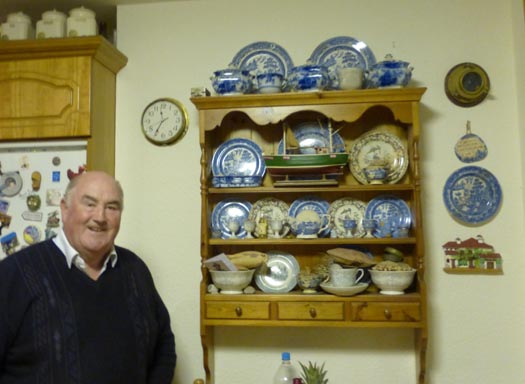
Aidan Sharkey of Clogherhead with some of his remarkable collection of salvaged chinaware. Photo: W M Nixon

The sort of sailing cruising folk dream of. Ainmara shaping up nicely to take the first of the fair tide through the islands at Skerries. Photo: W M Nixon
The morning brought the welcome gift of a decent little sunny east to nor'east breeze, and a lovely beam reach all the way down to Dublin Bay, with the south-going tide caught to perfection at the Skerries islands (and yes, I know it's superfluous to talk of the "Skerries islands", but that's what they're called to differentiate them from the Skerries off Holyhead).
Anyone who was involved in last weekend's ICRA Nationals at the Royal Irish YC will know how this premier club can lay on the welcome with effortless style. In the last weekend of May, Ainmara and her crew had the Royal Irish treatment all to themselves. Sailing Manager Mark McGibney ushered us to the prime berth right at the club where we found ourselves in a miniature maritime museum, with the Quarter Tonner Quest close astern (she was to become the ICRA National Champion a fortnight later), while just across the way was the S&S 36 Sarnia – back in 1966, the Sisk family set Irish sailing alight by bringing this very up-to-the-minute fin-and-skeg fibreglass boat back from builders Cantiere Benello in Italy, where they'd started series production on this ground-breaking Olin Stephens design before the same hull shape became better known as the Swan 36 built by Nautor in Finland.
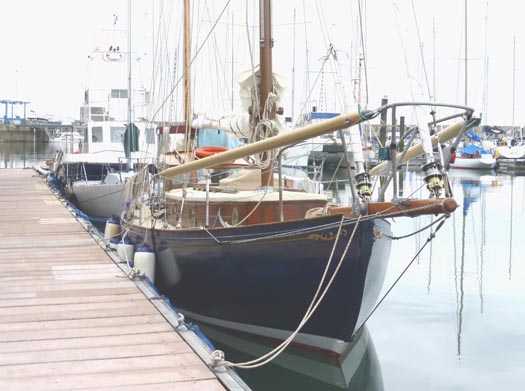
"Maritime museum" at the Royal Irish YC. Ainmara (built Ringsend 1912) with the 1987 Quarter Tonner Quest astern, and the 1966-built S&S 36 Sarnia across the way in her marina berth. Photo: W M Nixon
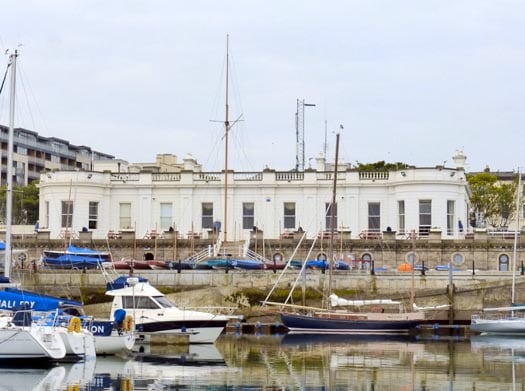
It has to be one of the best berths in the world. Ainmara at the RIYC – it's early morning, and the flags aren't yet hoisted. Photo: W M Nixon
The hospitality flowed seamlessly as the late afternoon graduated into evening and then velvet night. Ainmara is an extraordinarily effective calling card, and the stream of entertaining visitors brought laughter aboard before the Commodore moved us all up to the clubhouse and a fine supper and much chat with Michael O'Leary, one of the most visionary minds in Irish sailing, and his wife Kate and her people with tales of how she and longtime friend Clare Hogan are in the thick of things in the very healthy Water Wag class.
The RIYC took all this in its stride despite the fact that there was a big wedding going in the clubhouse at the same time, but it all went so smoothly that at one stage Ainmara's crew found themselves being invited to join in the wedding celebrations. However, we demurred because we were athletes in training for the Leinster Trophy next day, yet nevertheless certain key players in the wedding got themselves aboard Ainmara at a very late hour.
The plan for Saturday had been changed, but we were right up to speed with this as Denis Aylmer, the RIYC's key man in the OGA, had told us over a convivial pint that the likelihood of light winds had meant that Race Officer John Alvey had moved the scene of the action from Scotsmans Bay to a more compact race area close off the entrance to Dublin Port. It was all grist to our mill, as we could make an early morning departure and head up to Poolbeg Y & BC across a mirror-like bay, lining up the crew to salute the North Bank Lighthouse in the River Liffey, as it's something of a memorial to John B Kearney, whose day job was in the engineering department in Dublin Port and docks. With his original lighthouse, he pioneering a technique of screwing the piles into the seabed. You'd have thought an air of reverence would prevail, but with Ainmara's crew of anarchists, straight faces could only be maintained for about 12 seconds.
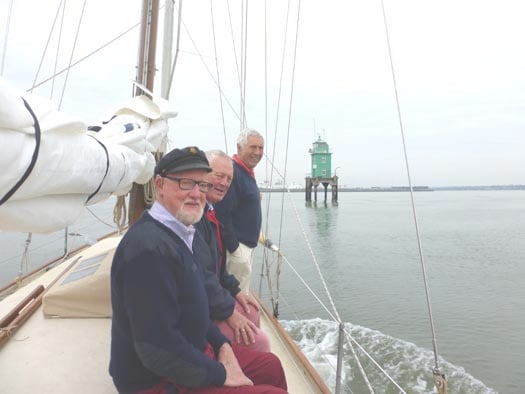
Trying to look appropriately reverential. Ed Wheeler, Brian Law and Dickie Gomes approaching Dublin Port's North Bank Lighthouse on which John B Kearney pioneered the use of screw piles. Photo: W M Nixon

"We're only here for the breakfast". Katy O'Connor's excellent catering in Poolbeg Y & BC is deservedly popular among visiting crews. Photo: W M Nixon
While we wanted to be well on time for the pre-race briefing, the main reason for getting promptly to Poolbeg was to take full advantage of Katy O'Connor's legendary breakfast at the club, and we put away enough calories to keep us going all day. At the briefing, John Alvey told us the committee were concerned that the very varied fleet – everything from Ainmara to the big Naomh Cronan, a superb Clondalkin-built re-creation of a Galway Hooker – included some boats which, in the light airs expected, could be out on the bay until nightfall.
So the plan was for a short race taking in several marks so that it could be finished at the end of any leg. But by the time we got down to Dublin Bay, it was crisp blue with a smart little sea breeze filling in to give sailing conditions which suited Ainmara to perfection, yet some of the heavier gaffers were still lumbering slowly about in what to them was a light wind.
They may have been lumbering about, but several were very determined to make a sharp start right on the committee boat. Anyone accustomed to quick-turning and fast-accelerating modern boats will find a fleet of traditional and classic gaffers a real education. They take time to get moving, they take for ever to stop, you point them a long way out, and their bowsprits – "dock probes" as marina managers call them – seem intent on skewering everyone else.
But while our skipper may pretend to be just an old cruising man these days, his racing blood was up. We set ourselves to sweep into what we hoped would be a gap starting to appear at the committee boat seconds after the start signal. We consoled ourselves with the thought that in extremis, we might just manage to shoot head to wind leaving the committee boat to port, ruining our start perhaps, but preserving the Ainmara intact.
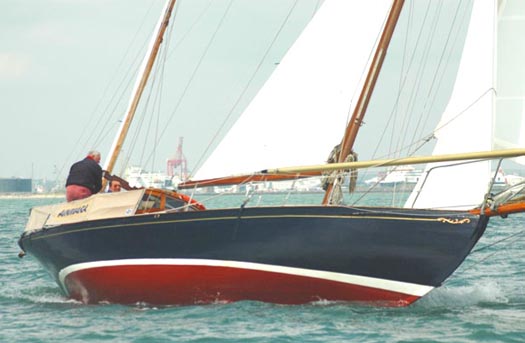
"Go for it, and let's hope there's a gap when we get there..." Ainmara starts to build speed towards her start in the Leinster Trophy Race 2014 . Photo: Gill Mills
So she was set at it, despite attempts to slow her a bit the speed built up, but as quickly as I'm telling this the gap started to appear and she zapped into it and just managed to keep her wind clear on Sean Walsh's remarkably fast Heard 28 Tir na nOg and Denis Aylmer's Mona. Now we had to find the DBSC marks in the right sequence, but Ed was on top of it feeding co-ordinates and giving out courses, we found that with a bit of luck we might just lay the first mark close hauled, and though Tir na nOg – whose waterline length is much the same as Ainmara's – hung in very well, he'd to tack for the mark while we scraped by it, so after that it was up jib tops'l and making hay.
But though we took line honours, we felt certain Tir na nOg would win on corrected time, as a Heard 28 sailed as well as she is can be one very potent performer, and Sean seemd to be still right on our stern at the finish. The results wouldn't be announced until Monday evening, so that Saturday afternoon we wandered back upriver to Poolbeg in sunshine so powerful that an afternoon zizz was your only man, and then we emerged on deck to find that others were arriving in port, with one of the the Welsh visitors, the engine-less Happy Quest from Milford Haven, making a copy-book job of berthing under sail, and then all was alive with the Howth Seventeens arriving in from their home port after a very close-fought passage race which had been narrowly won by Conor Turvey sailing Isobel.

Happy Quest from southwest Wales lives up to her name with a successful berthing under sail only at Poolbeg. Photo: W M Nixon
The Seventeens were there to put on a display race next day (Sunday) in the Liffey as part of the three day Dublin Port Riverfest over the Bank Holiday weekend. Inevitably for those of us who took part in the first one in 2013 when the OGA Golden Jubilee was top of the bill, there wasn't quite the same buzz, but first-timers watching aboard the restaurant ship Cill Airne assured us they found it very exciting indeed, and were especially impressed by the waterborne ballet of the two big harbour tugs Shackleton and Beaufort, while the funfairs and entertainment shows along the quays really did provide something for everything.
Once again the very sight of the Seventeens – which we in Howth tend to take for granted – was fascinating in the city setting. Though the promise of a decent breeze evaporated, Race Officer Harry Gallagher managed to get enough in the way of results to declare Peter Courtney with Oonagh the winner, an appropriate result for an historic class making a show performance, as the Courtneys have been involved with the Howth Seventeens since 1907.
I watched it all from an appropriate setting, aboard the Dutch Tall Ship Morgenster, a handsome 150ft brig which should be required visiting for anyone promoting the idea of a new Tall Ship for Ireland. For the Morgenster – which was re-configured as a sailing ship in 2009 – is run as a commercial venture, and can pay her way through being the right size to be a business proposition, helped by being based in the Netherlands. Thus she has a vast continental catchment area nearby to attract trainees of all ages and abilities who are prepared to pay enough for berths to keep the show efficiently on the road. There are several Dutch-based tall ships run in the same way, and the message is that if you're going to make a go of it commercially, you have to have a large enough and readily-accessed market to make it viable, and you need a boat big enough to carry sufficient trainees relative to the size of the ship – 36 in Morgenster's case – to balance the books.
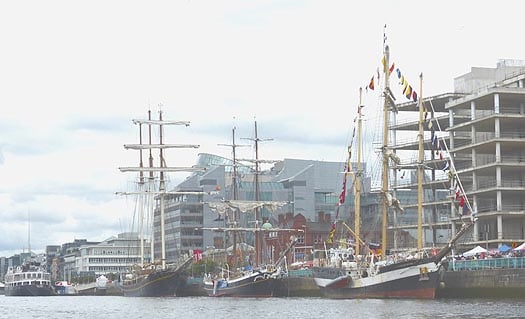
Tall ships in the Liffey, with the commercially-run 150ft sail training big Morgenster at centre. Photo: W M Nixon
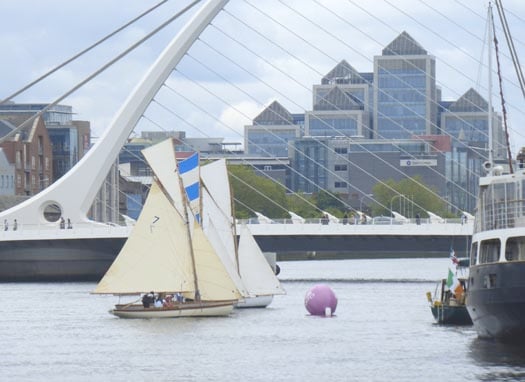
Sails and the city – Howth 17s at the Sam Beckett bridge Photo: W M Nixon
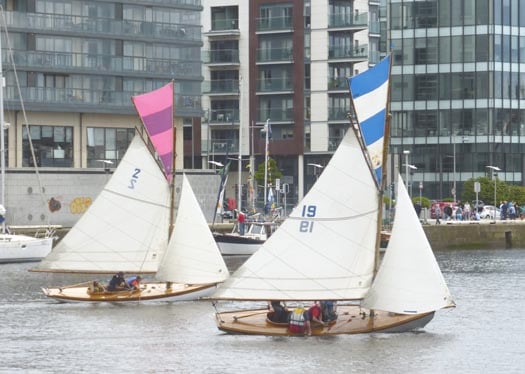
There was just enough wind for the first race for the Howth 17s to show what they could do in the Liffey if the breeze held up. Photo: W M Nixon
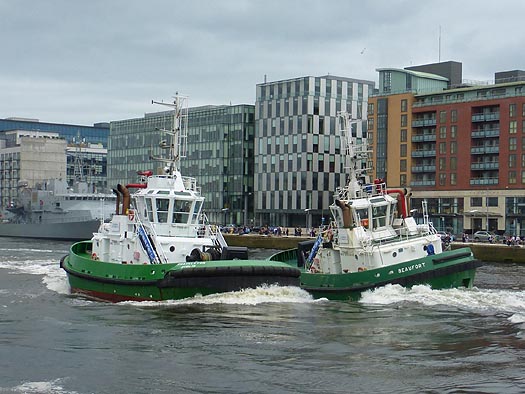
The Dublin Port tugs have awesome power to deploy in their waterborne "ballet" Photo: W M Nixon
But enough of solemnity. We went downriver again for farewells at Poolbeg, and then away across Dublin Bay and round the Baily for a seafood feast in Howth at the new place Crabby Jo's, and a handy overnight stop before using a good westerly next morning to give us a push towards Ardglass where we needs must stop, as the tides into Strangford Lough are a door slammed shut every six hours. But as ever, Ardglass's convenient and friendly little marina provided the perfect decompression chamber, and up in Mulherron's the crack was mighty with the crew of the famous restored Manx longliner Master Frank, just the two of them with skipper Joe Pennington - aka The Rat – being crewed by a psychiatrist who claimed to be strictly on holiday, but we did wonder, as any gathering of Old Gaffers is better than a wardful of nutters.
Ainmara's mini-voyage concluded next day with a text message from Dublin to tell us we'd retained the Leinster Trophy, which surprised us, and then with an idyllic sail in a sunny sou'wester, everything set to the jib tops'l, and all sail carried right through The Narrows, across Strangford Lough and thorough Ringhaddy Sound, and on across a blue sea among green islands past tree covered shores until we handed the sails just off the entrance to Down Cruising Club's isle-girt outer anchorage immediately south of Mahee Island, in a little sheltered area which has somehow acquired the unlovely name of Pongo Bay.

Home again. Ainmara back on her mooring in Strangford Lough, with Brian Law's classic yawl Twilight astern. Photo: W M Nixon
There, Ainmara is securely moored close to Brian Law's own cruising boat, the beautifully restored classic Lion Class yawl Twilight, designed by Arthur Robb. Like Dickie Gomes, Brian does all his own boatwork in a hayshed beside the house. So closely intertwined are their interests that they readily crew for each other, and of course the exchange of information and assistance and re-fit ideas is continuous.
And there's one further fact about these guys which may be of interest to other cruising crews. Aboard Ainmara during the three seasons in which I've cruised on her since she was restored for her Centenary in 1912, there's no kitty to cover expenses. There's an underlying feeling that as the skipper provides the boat, the crew owe him on a permanent basis. Thus if we get into a port and there's a choice between a comfortable marina berth or hanging off a quay wall, the crew will simply slip away and discreetly pay for a marina berth, and then tell the skipper it's a done deal.
Equally, when ashore for a meal, one of the crew will usually sidle off and pay for everyone when no-one else is looking. But if the skipper thinks the day has gone particularly well, you'll sometimes find he's paid for it all himself, As for getting diesel, whoever is carrying the cans will pay for it himself. Then too, when stores are required, it's covered by whoever goes to get them. It all sounds like an accountant's nightmare, yet so far, somehow at the end of the cruise everyone is content with the feeling that it has all balanced out, and as it has worked well for three years and longer, the attitude is that if it ain't broke, then don't try and fix it.
It had been hoped that Ainmara could stay on in the Dublin area for a week to do the Howth YC's Lambay Race in the Old Gaffers division on June 7th, as she won it in 1921. However, there was too much work still to be done to get her completely ready for a busy cruise programme coming rapidly down the line. But as she'll have to be back next year to defend the Leinster Trophy again, who knows but the double event might be done in 2015. As it was, her need for further fitting-out nearer to home was the saving of me, as a mighy temptation arose. The ancient Madcap from the north had stayed on in Dublin Bay, and was doing the Lambay Race with other old gaffers. The word on the waterfront is that Madcap may well be sold to France to be the centrepiece of a maritime museum in La Rochelle. So the Lambay Race might well be the last chance to sail on a 140-year-old boat. A place was secured on board.

The gaffers gather......Tir na nOg, Madcap and Naomh Cronan on misty morning in Howth before the Lambay Race. Photo: W M Nixon
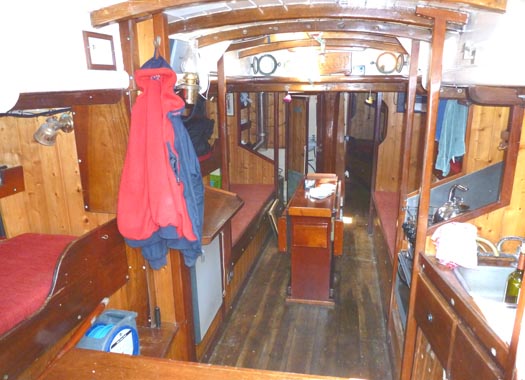
Madcap's sensible accommodation (above and below) reflects the seagoing needs of the pilots for whom she was built140 years ago. Photo: W M Nixon
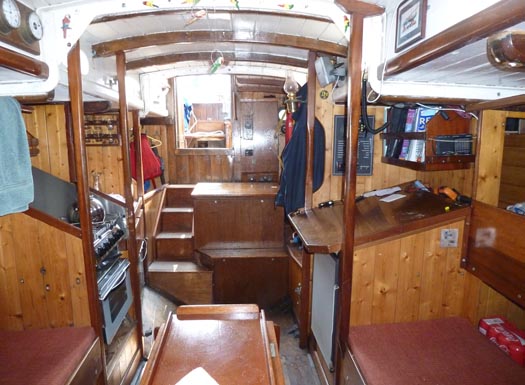
Madcap's owner for more than twenty years now has been Adrian "Stu" Spence, a rugged Belfast barrister who has the essential determination to keep such an ancient boat going. And going places too – he has been to Greenland and several times to Spain and Brittany, and has brought his old cutter through many a problem to log an impressive voyaging record.
If you have a boat of this age, your motto is: When God made time, he made a lot of it. Thus although the Old Gaffer's division was due to start at 1135, five minutes after the Howth Seventeens had set off through Howth Sound to sail the traditional Lambay course leaving Ireland's Eye to starboard and Lambay to port in order to celebrate the centenary of the Lynch family's Howth 17 Echo, it was pushing 1140 by the time we mde our leisurely debut to follow other other gaffers, which had Sean Walsh's keenly-sailed Tir na nOg soon disappearing into the misty asterly, followed by the Galway hooker Naomh Cronan helmed by the great Paddy Murphy of Renvyle, the Cornish crabber Alice (Mark Lynch) and then Madcp in her own good time.
With Northern Ireland Old Gaffers Association President Peter Chambers on the helm, Madcap settled gently into her stride, showing that she needs very little steering – she'll maintain a straight line for miles without the wheel being touched or secured in a any way. It's an oddly soothing characteristic, just the thing to calm a man down after a hectic week in the High Court, and she soon was making her own best speed with a bit of bite now in the breeze, putting Alice astern and keeping Naomh Cronan handily in touch.

"Is it always this foggy off Howth?" Stu Spence and Peter Chambers with he visibility closing in during the Lambay Race. Photo: W M Nixon
The mist became fog, but as ever it was difficult to tell just how thick it was until we suddenly found ourselves surrounded by wraiths in the gloom. It was Class 0 racing towards Lambay, and overtaking us just feet away, giving dramatic close-ups of some of the most likeable boats on the East Coast, with Stephen O'Flaherty's Spirit 54 Soufriere pacing it with Chris Hourican's First 47.7 Pretty Polly and the Tyrrell family from Arklow with their handsome J/122 Aquelina.
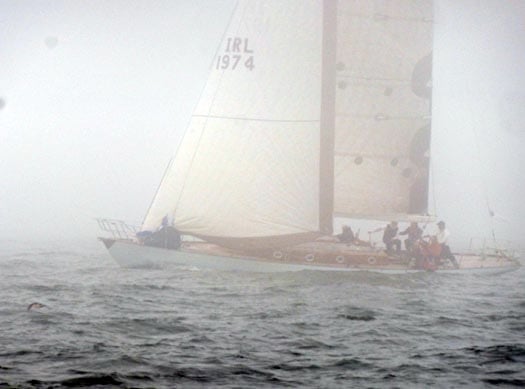
Do not adjust your sets, it really was this foggy for a while. Stephen O'Flaherty's Spirit 54 Soufriere in the fog during the Lambay Race Photo: W M Nixon

Chris Hourican's First 47.7 Pretty Polly in close-up Photo: W M Nixon
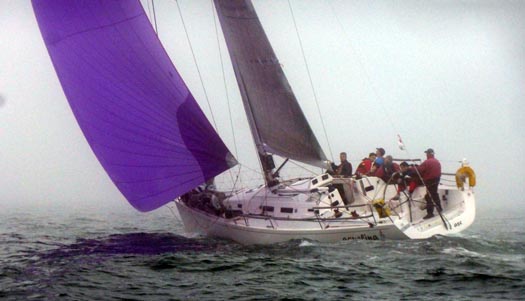
The Tyrrell family's J/122 Aquelina looking her best as she slices through the fog. Photo: W M Nixon
The fog was lifting as we got to the island with boats everywhere – the gaffermen were most impressed. Naomh Croanan had been overtaken, and Peter found us the perfect track along the flukey north side of Lambay, with Madcap effortlessly sliding over the smooth sea on a dead run and apparently consolidating her position.
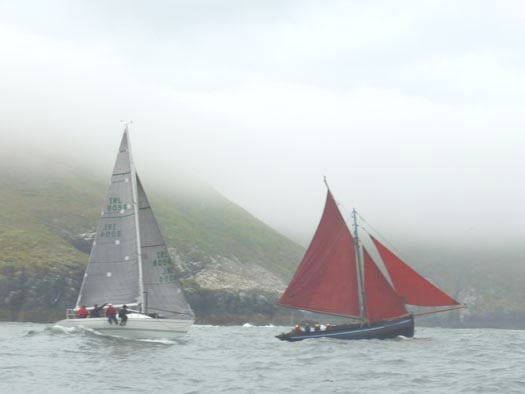
The fog start to lift. Dave Cullen's Half Tonner King One and te Naomh Cronan pproaching the east point of Lambay. Photo: W M Nixon
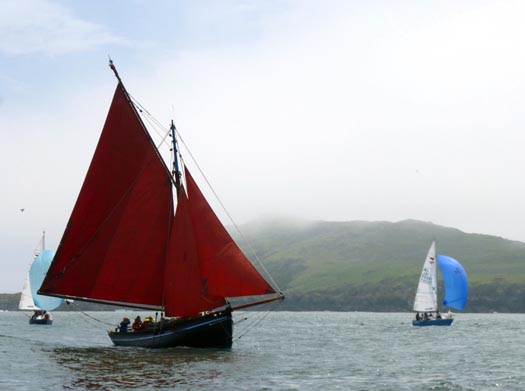
It could be Connemara...., .Naomh Cronan and two Puppeteer 22s off the north coast of Lambay Photo: W M Nixon

The long haul to the finish, the sun is out, and the breeze is beginning to develop enough power to suit Madcap. Photo: W M Nixon
But that was only until we started to head south back to the finish in Howth Sound. The Bermudan boats could lay it, so could the Seventeens, but poor old Madcap was even outpointed by Naomh Cronan, which Paddy Murphy very skilfully kept inside the line of foul tide in Lambay Sound and began to nibble at our lead, while we sagged to lee.
The sun was out, the sailing was lovely, we were surrounded by bustling classes of Puppeteer 22s and Ruffians 23s, and I suggested that a bit more tension in the jib luff, might do the trick, only to be told that as the bowsprit was no more than a liberated telegraph pole, it wasn't really up to the loads which would be put on it by trying to maximise the performance of a 22-ton boat, and nobody wanted splinters flying every which way aboard a boat where the mainboom looked to weigh at least half a ton.
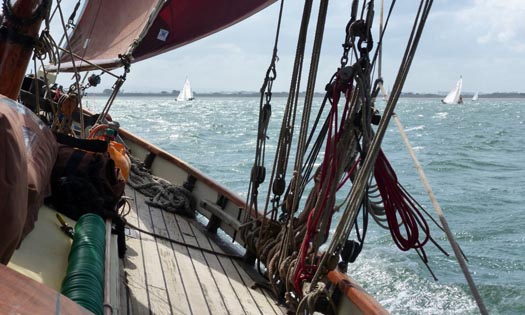
A bite to the breeze, with little boats everywhere – and all of them on starboard. Photo: W M Nixon

The Dun Laoghaire Ruffian 23s made a weekend of it for the Lambay Race, coming over on the Friday night, partying mightily, and then going out to race on Saturday in a rising breeze. Photo: W M Nixon
As it is the loads becme quite something as the breeze freshened sunny and squally down the north flank of the hjill of Howth. By the time we made it across the line, Madcap was going well on smooth water under just mainsail and staysail. But though Naomh Cronan was still ahead and rightly delighted with themselves at getting a good second, it was Tir na nOg which had been in race of her own. Yet as Sean Walsh reported with astonishment, he hadn't been able to get among the slippy little Howth 17s, where John Curley and Marcus Lynch had a good win with Rita, Howth Seventeen No. 1.
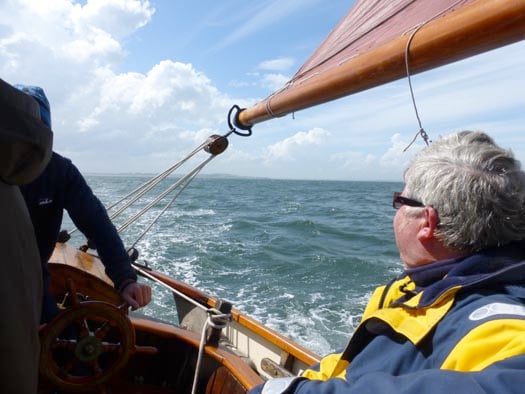
Finally there was enough breeze for Madcap's wake to stretch satisfyingly astern while she could point better with the jib brought in, but Naomh Cronan still finished ahead to take second prize. Photo: W M Nixon

The mighty helmsman of Renvyle. Paddy Murphy (left) steered Naomh Cronan to an excellent performance in the Lambay Race 2014. With him is DBOGA Hon Sec Gerry Murtagh with a trophy he won racing round Lambay in 1986. Photo: W M Nixon
It seemed an Old Gaffers Classic Lambay Race had been inaugurated, and Sean Walsh, international President of the OGA, was most appropriately the first winner. It was something to celebrate, and it duly was, in the sunshine at Howth YC. But in time, I had to take myself away and go for a long walk with the little dog along the beach. For when you've been sailing on a 140-year-old boat, there's a need to ponder the passing years, and this crazy sport of ours in which museum pieces are part of the action.
#cruiserracing – The opening day of the ICRA Nationals at the Royal Irish YC in Dun Laoghaire offered W M Nixon the chance of a painless transition through Friday 13th, and the discovery that there is a life after spinnakers.
In the complete absence of any completely new boats in the hundred-plus lineup for the Irish Cruiser Racing Association's three day Nationals on Dublin Bay, it made sense to focus instead on the lovingly maintained and upgraded veterans in the fleet by sailing on a boat which has been an important part of the Irish sailing story since 1979.
The 30ft Club Shamrock Demelza (she's named after the heroine of a long-forgotten TV drama series based in Cornwall) was one of ten or so boats which raced as a hyper-keen almost one design class in Crosshaven in the late 1970s and early '80s.
Ron Holland's Shamrock Half Tonner design had been achieving racing success since it appeared in 1975, with Silver Shamrock – skippered by Harold Cudmore with all the usual suspects in the crew – winning the Half Ton Worlds at Trieste in 1976. But although they were able little boats with adequate accommodation – American sailor Stuart Woods crossed the Atlantic single-handed in one – the more clubbable element in Royal Cork persuaded the designer and the builders in Cork that a Shamrock with roomier accommodation made possible by a much larger coachroof, with a shorter cockpit and wheel steering, would better meet the needs of club sailors.
For the more austere racing types, the Club Shamrock which emerged from all these discussions looked to be a frivolous boat for party animals, rather than a serious racing proposition. But it speaks volumes for the basic quality of the Ron Holland hull design that the "comfy party boats" could hold their own very well indeed inshore and offshore, if competently sailed.
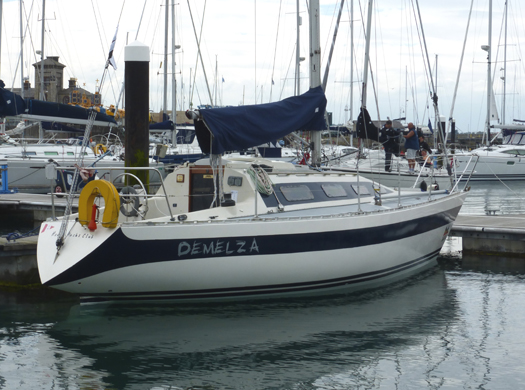
The pintail stern on Demelza makes her very slippy to windward, but her performance suffers on a reach. Photo: W M Nixon
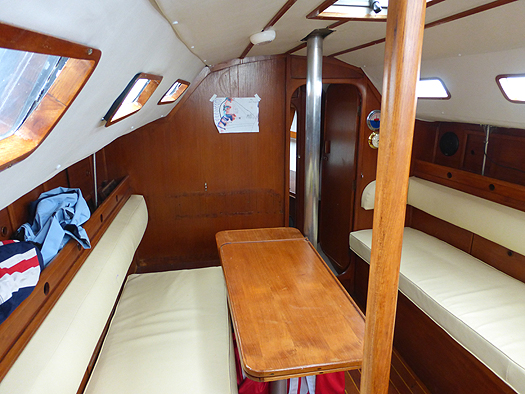
The Club Shamrock version provided a saloon which seemed exceptionally roomy in the 1970s. Photo: W M Nixon
Thus Brian MacManus of Dun Laoghaire, who owned and campaigned Silver Shamrock herself for ten keenly contested offshore seasons in the Irish Sea, remembers that it was the devil's own job getting clear ahead of the almost clunky-looking Club Shamrocks, and it was wellnigh impossible when that Club Shamrock was Demelza, owned and sailed by Neville Maguire.
But we're getting ahead of the story. Back in 1979, Demelza was a new build for Stafford Mansfield of Crosshaven. A key member in his crew was his schoolboy son Mark, later an Olympic sailor and still very much in demand as a frontline helmsman. But back in the late 1970s, it was Demelza which propelled young Mark into the offshore racing game.
He modestly recalls that they won more than their fair share of prizes. But as the boat was raced with complete dedication, there was nothing unfair about their haul of trophies. Eventually, with their sights on the db1 Luv Is, the Mansfields sold Demelza on to Neville Maguire of Howth, thereby bringing another name of international sailing repute into the story, as it was aboard the little boat that Gordon Maguire made early forays offshore.
However, Demelza could win whether Gordon was there or not. In 1984, on the very weekend in August that saw Gordon winning the Irish Windsurfer Nationals in Kerry, in the Irish Sea Neville won the concluding race of the ISORA Championship to take the title – and that in a year in which he had also won his class in the Round Ireland.
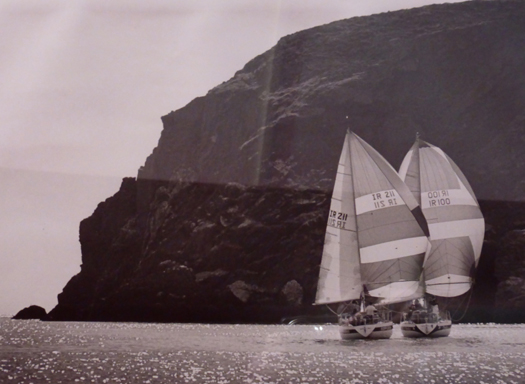
Glued together. Harry Byrne's Club Shamrock Rapparee and Neville Maguire's sister-ship Demelza in one of their many contests during the 1980s, seen here closing in under Howth Head while positioning themselves for the lee mark.
The Club Shamrocks found a new lease of life in Howth, and for many years a feature of the racing there was the continuing battle between the sister Club Shamrocks, Harry Byrne's Rapparee and Neville Maguire's Demelza. They seemed to be glued together in some races, and years afterwards they can still recall every last move afloat, and the final outcome of dozens of contests.
Neville Maguire had long since celebrated his 80th birthday when he sold Demelza to Windsor Laudan and Steffi Ennis for what is only the third ownership in the boat's gilded existence. Steffi Ennis is longtime Howth sailing family, while Windsor is Irish Sea through and through. His boyhood was spent at picturesque Porth Dinnllaen in North Wales, where his parents ran the famous pub on the beach, then when he was 16 they moved to Holyhead and he became so involved in offshore racing that after zillions of crossings of the Irish Sea, he became Howth based.
Demelza is one very lucky little ship, so where better to spend Friday 13th June? In Windsor and Steffi's ownership, she has people who appreciate her good qualities, which are many, for she's one gallant little boat. And as for the fact that when the spinnaker is set the Shamrock can be a right handful, well, they've solved the problem simply by opting to keep her as a much-loved family cruiser while racing her in the non-spinnaker class.
That said, they've raised non-spinnaker racing to a new level. Last year, they were right on the pace, winning the Lambay Lady for the clearest win in Howth's annual Lambay Race, and topping their class with six bullets in the Volvo Dun Laoghaire Regatta. All this despite the fact that the Club Shamrock's very pintailed hull is at a distinct disadvantage when reaching, or when running in anything over Force 4. So clearly this pair of keen owners are employing some very special skills, and the opening day of the ICRA Nats offered an opportunity to find out just how they do it, and also to get the flavour of this year's main regatta on the east coast.

Good start to the day. With Howth Head well astern across Dublin Bay, the rest of the crew catch up with the commuter boat as Demelza enters Dun Laoghaire Harbour.
Photo: W M Nixon
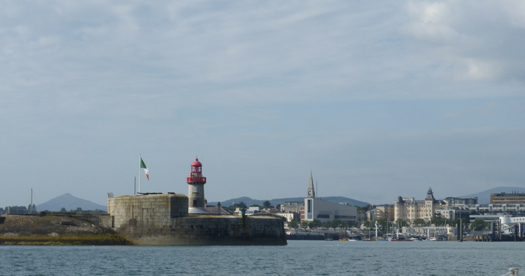
The intrusion of the new library into the Dun Laoghaire waterfront is a shock for those who haven't seen it before. Photo: W M Nixon
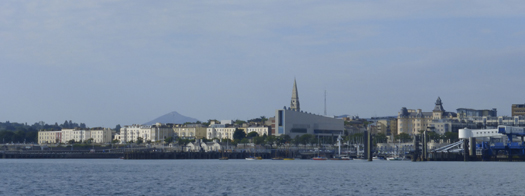
It is only from mid-harbour that you're fully aware of the damage done by the new library to Dun Laoghaire's classic waterfront. Photo: W M Nixon
Being on time is a good start. Ship's orders for visiting journos were to be aboard with the skipper and mate by 0800 in Howth Marina, and get the boat to Dun Laoghaire Marina comfortably in time for the rest of the crew coming across Dublin Bay in a fast runabout which would subsequently be used for daily commuting while the boat stayed on in Dun Laoghaire, all to be well in time for first gun at 1055hrs.
The sense of anticipation is palpable, and while the sight of the new "library and cultural centre" blighting the Dun Laoghaire waterfront was a shock for those who hadn't been it before, at the Royal Irish the happy morning mood took over again, with the place ahive with activity which is comprehensible only to regular regatta racers, and confusing for those not in the loop.
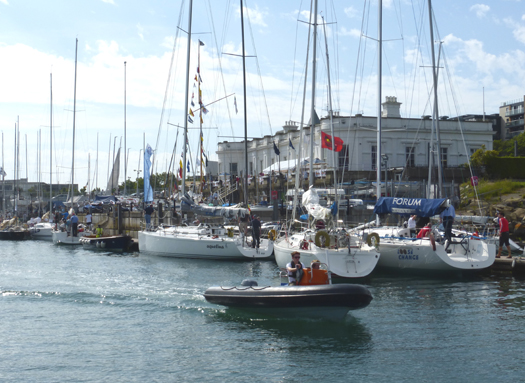
"Glad morning again". The Royal Irish YC is the perfect setting for that special pre-regatta sense of anticipation. Photo: W M Nixon
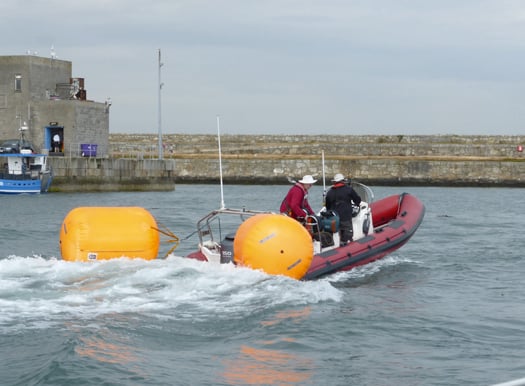
The Dun Laoghaire regatta machine swings into action with supplementary race marks heading seaward. Photo: W M Nixon
Sufficient to say that once again the mighty Dun Laoghaire regatta machine was moving smoothly into action with three different race areas being provided in the bay, and on the waterfront the club gearing up to receive a host of hungry and thirsty post-race sailors. There was a nice moment when Mark Mansfield – up in Dublin to helm John Maybury's J/109 Joker II in the Nationals – called over to say Demelza had never looked better. Other old friends to meet and greet - do other sports have quite the same level of banter as sailing? – and then out to the Bay and suss up the opposition.
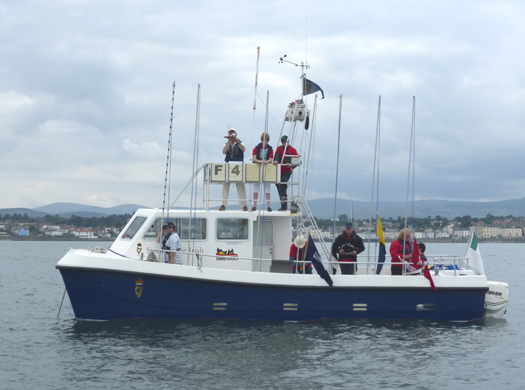
Were it not for the many volunteers manning the committee boats, an event like the ICRA Nationals simply couldn't happen. Photo: W M Nixon
There were two obvious boats in Class 6 for Demelza to beat – Jim McCann's Mustang 30 Peridot, and Sean and Kristina O'Regan's Dehler 31 Vespucci. But an unexpected addition to the lineup of ten or so boats was Frank Friel's Fist 32s5 Effex II, usually completely a cruiser and thus given a low ECHO handicap. So she was in among smaller craft, but this provided another handy target boat for the Laudan-Ennis team.
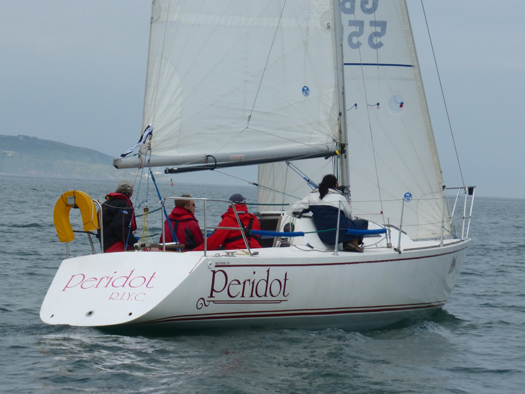
Jim McCann's Peridot was an ideal competitive match for Denmelza. Photo: W M Nixon
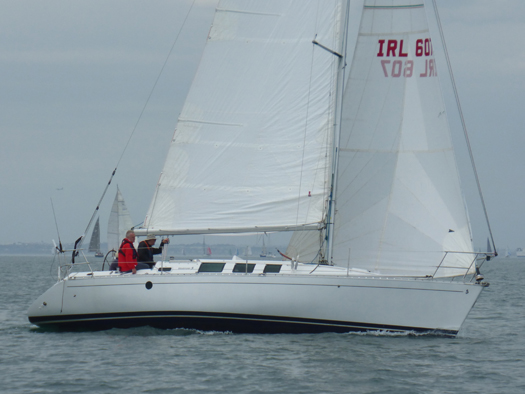
Frank Friel's Effex II took line honours in the first race. Photo: W M Nixon
And that's exactly what they are. A team. It worked beautifully in the countdown to the start, with Steffi putting the course on cockpit display and keeping tabs on time and any other messages via VHF, while Windsor was able to settle into the developing day, getting a sense of what the wind was trying to do while exchanging ideas with his afterguard of Conor Walls and Francis Ennis (Steffi's dad).
They set a hot suit of brown sails on Demelza's masthead rig, with a main from North while the genoa is Philip Watson. Within the limits of doing without spinnaker, everything is optimised and the light breeze from southeast, sometimes swinging a bit more east, is getting a useful bite to it as the first of the ebb is running southeast across our start area in the outer water of Scotsmans Bay.
As is usually the case, in these conditions on the initial beat it pays to go to the wall, closing the shore with Demelza powering along and loving it - after a good start, our skipper finds clear wind and makes the most of it. Fortunately the downwind leg become a dead run, and a masthead-rigged boat can make hay running goosewinged, but even so our lead is under increasing threat from the First 32s5, and Effex II just pips us for line honours, though on IRC Demelza has it by a mile.
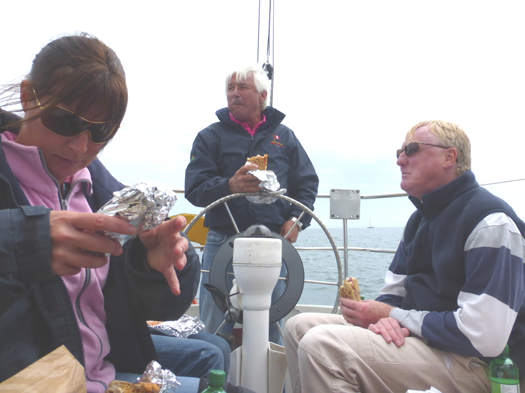
Lunch break – but definitely no alcohol until racing is finished for the day. Photo: W M Nixon
The mood over lunchtime sangers is of good work done, but more work still to do. But then that wretched new library intrudes again. You just can't get away from it. While it looks bad enough from within the harbour, from Scotsmans Bay it looks ten times worse. Out there, you can see how it has entirely blocked off a pleasant terrace of classic Dun Laoghaire waterfront houses from any enjoyment of the sunset. Compared to this new monstrosity, the Berlin Wall was surely a lovely creation.
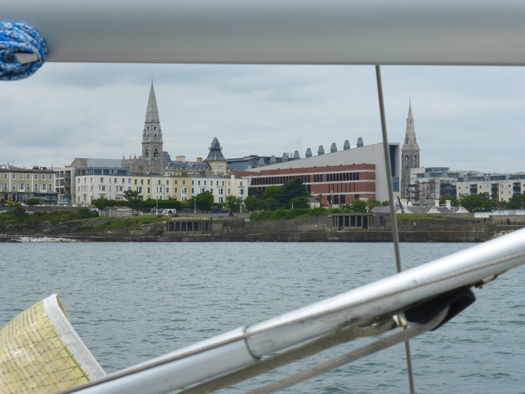
You just can't get away from it..........
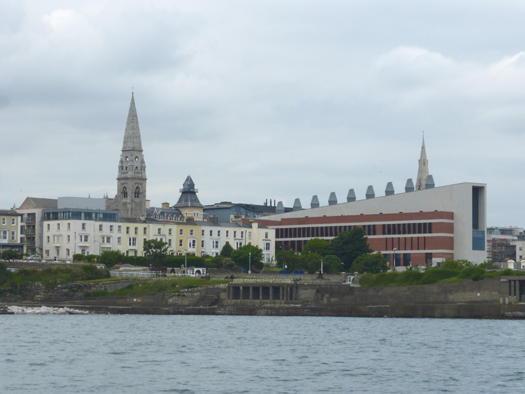
.........and farewell, Sunset Strip. The new Dun Laoghaire library has permanently blocked off the sunset for an entire terrace of houses. Photo: W M Nixon
But fortunately for our entertainment, we had a glimpse of other divisions racing, with Classes 0 and 1 running past nearby, and Denise Phelan's Ker 37 Jump Juice up from Cork doing great things on the run to make up lost ground. For the biggies as for us, the beat out of Dublin Bay was tactically fascinating as the ebb had reached full strength. Jump Juice read it to perfection, even if her winning tack on port brought her right through our starting area.
But once again the Dun Laoghaire regatta machine took it all calmly in its stride. And when we came to make our start, our skipper read it spot on, working his timing and the sluicing ebb to such an accurate level that we swept by the committee boat only a nano-second after the signal, and had congratulations from a race officer for getting it just right.
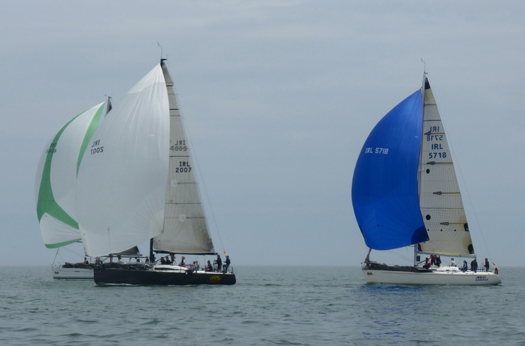
Jump Juice from Cork starting to make up lost ground on the run in Class O Photo: W M Nixon

Winning tack. Jump Juice came down the bay in impressive style hard on the wind............Photo: W M Nixon
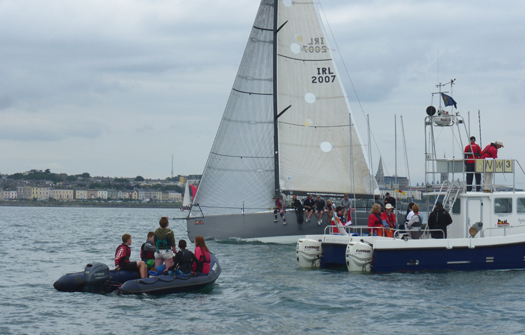
...........and her win move took her right through the Class 5 and 6 start area, but nobody batted an eyelid............Photo: W M Nixon
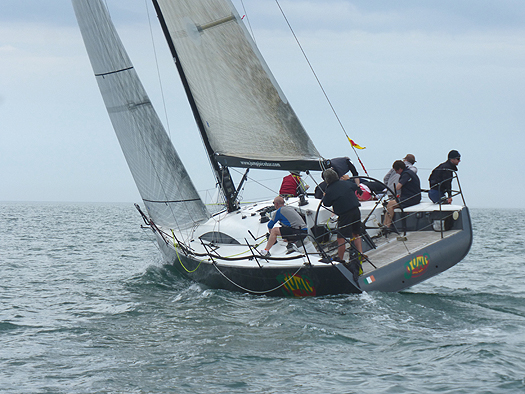
.....and it gave us an exciting glimpse of a top level racing machine. Photo: W M Nixon
That second race saw us sharing some sea space on the run with Classes 0 and 1, and as we were on starboard and interested only in maintaining our lead, some very expensive floating hardware had to throw some very neat gybes to allow the little Demelza to progress on her rightful way. But our afterguard being total boat addicts, they enjoyed nothing more than giving chapter and verse on each boat which came within range.
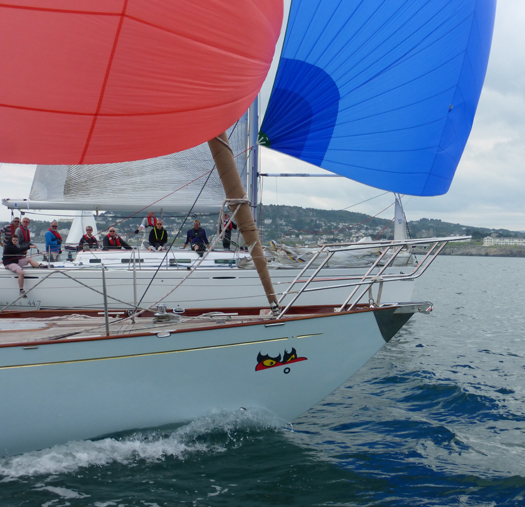
Mixing it with the heavy metal. The bows of the 54ft Soufriere and the 45ft Lively Lady after they'd neatly gybed their way out of a close encounter with the right-of-way Demelza. Photo: W M Nixon
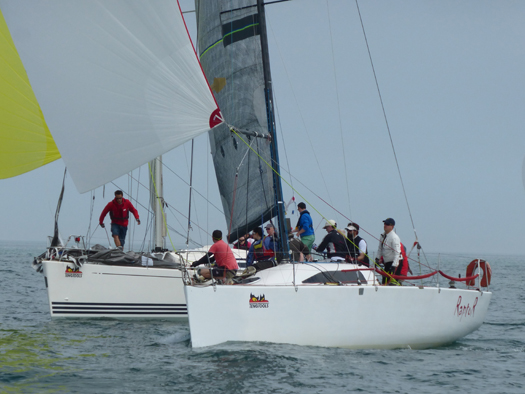
Raptor getting up to speed. She was one of the earliest Mark Mills designs, and was originally known as Aztec. Photo: W M Nixon

Tony Fox's Gringo, an A35, finds some sun on Dublin Bay. Photo: W M Nixon
The final beat saw Jim McCann with Peridot almost getting through, but sailing is a supposedly genteel sport which can show a discreetly killer side, so Windsor and Steffi were only delighted to throw a slam dunk right on top of their old friend, and go on to take line honours and their second corrected time win of the day.
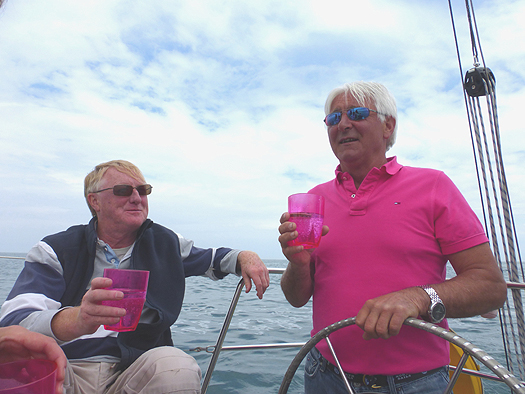
Second win, and line honours too – a bit of celebration for Conor Walls and the skipper. Photo: W M Nixon

Demelza's current success is put down to the permanent presence on board of a lucky Welsh dragon. Photo: W M Nixon

A crew of friends – racing Demelza to success are (front row, left to right) Windsor Laudan, Steffi Ennis and John Aungier, back row Francis Ennis, Conor Walls and Debbie Faherty Photo: W M Nixon
The morning's sunshine had given way to a silver-grey blandness in the weather, and to a casual observer, there might have seemed some blandness to the day's racing. But not for those taking part. I've long thought that trying to make sailing a spectator sport is a waste of time – either you take part, or you go off and watch something exciting like gardening. We'd had a marvellous day's sport, and it was followed by the usual high-octane banter at the club. The ICRA Nationals 2014 had got off to a good start. The race officers had their beloved results, with only one more race to sail to have a recognised championship. Let's hope the sun comes out today to sharpen up the sea breeze. Meanwhile, it was only after I got home I remembered it had been Friday 13th. And as for spinnakers? Well, believe me, there's life after spinnakers, there really is.
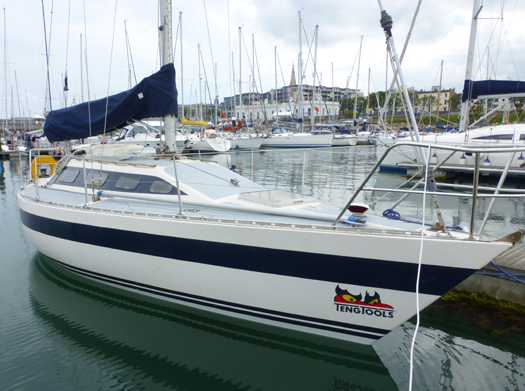
A well-loved little boat at rest after a good day's racing. In her successful 35 years, Demelza has been in only three ownerships. Photo: W M Nixon
#hyc – With only a week to go anticipation is building for the inaugural HYC Sportsboat Cup at Howth in County Dublin writes Ross McDonald.Three fleets will be battling it out over two racecourses in what is promising to be a spectacular addition to the Irish racing calendar. Racing will begin on Friday the 20th June and run over the weekend on what is the longest day of the year.
Racing will start at midday each day but the fleets will be back on dry land in time to take advantage of the late evening sun. Post sailing music and barbeques are booked for each day along with a sailing supper by HYC's new chef Jason Dunphy (ex Rolys, Conrad and more) on offer for Friday evening. On Saturday evening there will be a midsummer celebration with a dinner dance organised so the club will certainly be a lively spot.
The 1720 Europeans will be held as part of the event which is drawing an international flavour to the racing, with boats travelling from the UK to compete for the title. This is the first time in several years that this event has been held out of the 1720 stronghold of Cork and it is giving the boats from Dublin a new lease of life. Entries are coming in from the host club as well as The Irish, The George and the INSC in Dun Laoghaire. That's not to mention all of the old heads that are popping up on some of the regulars boats to rekindle their love of the 1720 and impart some local knowledge while at it. Boats are starting to arrive this weekend with the aim of familiarising themselves with race area.
The J24 fleet will be hotly contested with several seasoned campaigners and previous regional and national champions battling it out for the title. The fleet have lots of experience racing in Howth and are returning to the battleground of last summer's Worlds and the Europeans from 2011.
The J80s will be populated with lots of notable sailors across a wide range of ages. From young Oppie champions to world match racers and everything in between this racing is promising to be memorable. With all the boats rigged and tuned identically this fleet will come down to nothing but the sailors skills.
As well as awarding fleet prizes a perpetual trophy will be awarded to the overall event winner. The details of how it will be decided will be revealed in the SI's.
There is still time to get an entry in. You can enter online here
Howth Yacht Club Double-Handed Yacht Race Challenge to Feature Kish, Rockabill & Lambay
#hyc – Howth Yacht Club will run an open double-handed race on Saturday, August 23, 2014 for both spinnaker cruiser classes and white sail cruiser classes. The course will use the Kish Lighthouse, Rockabill lighthouse and Lambay and will start and finish at Howth's East pier. The course will be approximately 40 miles with a start time of 10am and hopeful finish time of late afternoon.
Double handed sailing is the fastest growing fleet within the RORC race calendar and so this challenge will give a taste of shorthanded sailing to HYC crews and hopefully will attract visitors from other local clubs.
Preparation and participation in the HYC Double handed Challenge is a great way for competitors to build shorthanded sailing skills and have a safe fun passage.
So put this in your diary, pick a crew (just one) and go for a practice sail. Entry forms, Notice of Race and Sailing Instructions will be posted soon.
Lambay Race Win for 'Bite the Bullet' off Howth
#lambay – Howth Yacht Club's 2014 Lambay Races were supported by a keen fleet of almost 120 boats, from the modern day stripped-out racers to equally spartan machines of 1898 writes Emmet Dalton. The Howth 17 Footer and Old Gaffer fleets avoided the nasty, modern business of a beat to a windward mark and started a half hour earlier from Howth's East Pier and made directly for Lambay. Selected results available to download below.
Meanwhile, their younger brethern, forever spending money trying to go faster, spent additional time sailing in the wrong direction from inshore and offshore start lines towards windward marks before deciding to turn towards the target.
Exotic materials are never a guarantee of success as the "Back" of Lambay snorted its usual laugh at the leaders. Skippers who bit off five metres too much or little towards the crags were rewarded with nothing more than gull droppings on their decks or inadequately muffled slagging from their faster moving neighbours.
The early part of the day didn't hold out much promise of the golden orb breaking through but as the race progressed and the rounding of a fog-cloaked Lambay was completed, there was enough sun to allow the salt to caulk on the faces of those closer to the front of boats.
This term's Top Boy was Colm Birmingham and his chums who took "Bite the Bullet" on a faster field trip than the other classes, bagging the (Anatomically perfect) Lambay Lady.
From our 17 Footer reporter, Mary Faherty:
Rita took the lead at the start. However Ian Malcolm's Aura overtook her just past Claremont Beach followed closely by Oona. Then the whole fleet disappeared into the heavy fog. Lambay was no where in sight and everyone was guessing compass bearings. When the sun finally broke through the fleet was just to the east of Lambay, again with Rita just in the lead. She held her position and rounded Lambay in first and finished a whooping 4 minutes ahead of the next boat. Oona and Aura raced for second place on the water. Hugh Walsh who had taken Sheila for the race and walked away with the handicap prize
Details from the Puppeteer 22 Class Captain, Cabbage Kavanagh:
In the Puppeteers the 14 boat fleet started with a short beat, rounded the windward and headed into the mist in search of the eastern end of Lambay. As always the racing was tight. After exchanging the lead several times, Eclipse slipped ahead of Blue Velvet behind the island and held on to take the BP/Teeling trophy on scratch, with Harlequin in 3rd and Odyssey squeezing in 4th, showing good speed on one of their first outings of the season. In the handicap division experience told with Cloud 9, rumoured to have competed in every Lambay race since 1906, taking the John Pearson cup, ahead of Schiggy in 2nd, Enigma in 3rd, doing well on their first attempt at Lambay, and Geppetto in 4th.
#hyc – This weekend, Saturday June 7th, Howth Yacht Club once again hosts one of Ireland's longest established events, the Lambay Races. The event has been part of Howth's sailing calender for well over 110 years, the first trophy dates back to 1899 and was put up by a member of what was then Howth Sailing Club.
Saturday's event is proudly sponsored again this year,by Trustee Decisions Ltd. - a specialist company providing professional advice to trustees of private and public group pension schemes.
Apart from the usual inshore and offshore fleets, HYC will also have a throwback to the traditional Lambay races with the Howth Seventeens starting off the east pier and finishing in Howth Sound. The return to the tradtional Lambay course was discussed recently in WM Nixon's Sailing blog.
There will also be a pier start for classic boats which will hopefully include a Galway Hooker.
This change in format for traditional classes is the idea of Bryan Lynch and is to mark the centenary of Echo (no. 8) which has been in the Lynch family since 1969 and is currently owned and skippered by Bryan's daughter Harriet.
As the entries roll in, it seems that the Puppeteers will end up being one of the biggest fleets. Every inch of the 16 or so mile race track will likely be needed by whomever will end up claiming the Lambay Lady trophy, which is awarded to the boat that wins its class by the largest time differential over the boat that comes second.
Leaving aside the excellent racing that the event usually provides, the onshore festivities start early on Saturday morning with coffee and bacon rolls, bar food and barbecue available all day, the prize giving will take place at 17:30 and dinner is available in the dining room from 18:00 (booking essential).
Music and dancing will be provided by Buck Taylor, a James Taylor tribute act with DJ David O'Shea continuing the fun until late.
Entry is available on line here
#etchells – Ireland has a single entry in a 95–boat fleet for the 2014 Etchells keelboat World Championship from June 21 to 28 in New York. The class's 46th world championship will be one of the biggest and most competitive in its celebrated history.
Malahide and Howth Yacht Club sailing family trio, Richard, David (a four time Olympian) and Samantha Burrows are entered in the Corinthian, Masters and Seniors divisions in a fleet that has already attracted some of the world's top professional and amateur sailors.
Long Island Sound yacht designer and builder Skip Etchells created the 31-foot keelboat in 1965 hoping to win selection as the new Olympic keelboat.
The design dominated the racing in the selection trials, but lost in the onshore voting for Olympic status. For the 2016 Olympics, there will be no keelboat sailed in the Olympic regatta.
But nearly 50 years after the first Etchells touched the water, the class is as strong as ever.
The number of entries in recent class world championships has varied from 41 last year to a high of 100 in 1998.
Up to nine races are scheduled, all but one of which will count toward a team's final score. Registration and measurement for the regatta will start on Saturday, June 21, with the racing taking place on Rhode Island Sound, Tuesday, June 24, through Saturday, June 28.
For an entry list click here.
#hyc – Simplify the courses, make the starts more accessible, and sign up interesting boats, ideally with historical interest - those are some of W M Nixon's suggestions for stimulating sailing.
They're going back to their sailing roots in Howth. The historic Lambay Race in a fortnight's time will re-introduce the traditional direct course round the island for both the venerable Howth Seventeens, and a special class for Classics and Old Gaffers.
The annual race round Lambay has been a part of the local sailing calendar for at least 110 years. With the first known Howth regatta being staged in 1857, doubtless the island was used as a very clearcut race mark several times during the 19th Century. But it wasn't until 1899 that a Lambay trophy was finally put up by a member of the relatively new Howth Sailing Club (founded 1895), and it is 1904 before we find any reference to such a race being held.
Howth SC was a tiny club, and the earliest records of its sailing results are very sketchy. To keep the tally, they often ended up relying on inscribed trophies and the occasional newspaper reports. But trophies went missing, and with the big clubs on Dublin Bay and Cork Harbour getting any media attention going, Howth scarcely registered on the newspaper radar at all. Then with six members – or more than 10% of the active membership – killed during the Great War of 1914-18, there were other things to think of, and it isn't until the 1920s that we have anything like a clear idea of what was going on with the Lambay Race.
The way it was reported suggests that it had been a well-recognised event since the early 1900s, and the course was firmly established. Start off the pierhead (time to be taken from Findlater's clock), through the Sound leaving Ireland's Eye to starboard, then round Lambay leaving it to port, and back to the finish through the Sound, this time with Ireland's Eye to port. It's only about 16 miles in all, but it can be a course with a bit of everything.
And it was so beautifully simple - even the business of hitting the main mark of the course didn't merit disqualification as you were aground, and had more than enough problems to be going along with, without being chucked out of the race as well.
It was a format which worked well until the 1970s, when fancy notions of always having windward starts from a committee boat, with all sorts of other course permutations round laid marks, were added to the ancient mix. This new approach worked well enough for a while, as sailing numbers were increasing in any case. But the new devotion to serious racing began to stray from the old Lambay ideal of celebrating a coastline by racing round its main island.
Thus at a time when the straightforward Round Gotland Race in Sweden was building its steady rise to becoming the Baltic's most populous sailing event, and the equally straightforward Round the Island race round the Isle of Wight in the south of England was doing the same in the Solent, the much longer established Lambay Race in Ireland was straying further and further from the attractive simplicity of its original concept. Gung-ho Race Officers, obsessed with the ideal of the Olympic-style course, began setting ever-more artificial courses in which Lambay was so much reduced to being merely another mark of the course that, on one eminently forgettable occasion, the fleet didn't actually round the island at all.
My own disenchantment with the new regime came on a day of light westerly winds, when a Race Officer obsessed with fitting in a long windward leg set a Lambay Race course which also took in the Kish Lighthouse eight miles offshore. As it happened, our crew included two guys who had to be in Athlone that night by 9.30pm in order to play a weekly gig with a showband. In those pre-motorway days, just getting to Athlone was a night's work in itself. So when the breeze faded, we'd to pull out so they could get to work on time.
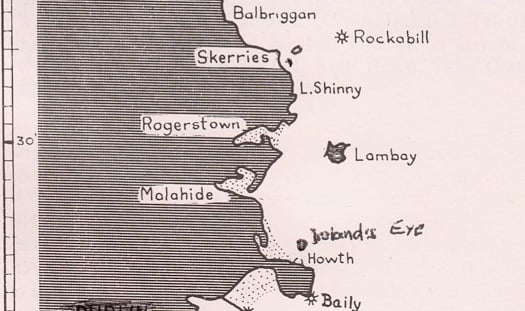
What could be simpler? A basic course using Lambay as the turning mark removes cockpit confusion
As it happens, the breeze filled in just enough for those still racing to complete the course minutes ahead of the absurdly late time limit of 8.0pm. With the calm in the middle, and then the better wind filling in later, the handicap placings were simply the reverse order of boat size. The smallest boat won, and as we were the second smallest boat racing, had we been able to stick at it we might have been at least second. Yet the disgruntlement wasn't directed at the demands of showband gigging in Athlone. On the contrary, the annoyance was with race officers who think that even the most traditionally fun-filled racing celebration of a beloved island and its nearby area of Irish coast should be made such a deadly serious business.
Just now and again, we need to lighten up in our sailing. By all means be vigilant in safety and in respecting the rules of the road in seafaring. But for heaven's sake just once in a while, let's race a simple course along attractive bits of coastline as much for the fun of being among other boats and sailing the sea, and the beauty of the coastline, as for the competitive sport involved.
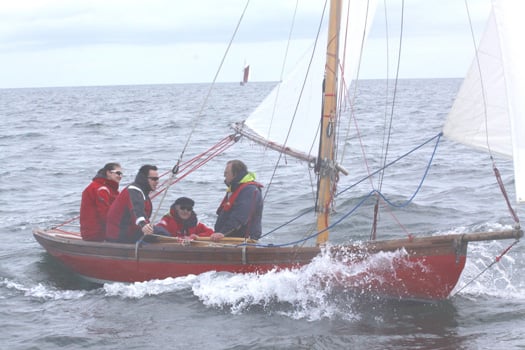
The folk who have made it happen. Harriett Lynch on Echo's helm (left), with her father Bryan second from right. Our photo shows them last year as they were about to demonstrate to the Old Gaffers how to do it, by sailing their engine-less little boat round the Kish despite forecast of calms. This year, to celebrate Echo's Centenary, they and the rest of the Howth 17s will sail a traditional course round Lambay. Photo: Dave Owens
For this year's Lambay Race on Saturday June 7th, there's a glimmer of fresh hope. Bryan Lynch is a stalwart of the Howth 17 class. He has been involved with these attractive little boats since at least 1965, when he and his brother Mark bought Pauline, No 2. Then they were out of ownership for a little while, but soon back in together again with Echo (No 8) in 1969, and then in 1974 Bryan became Echo's sole owner as Mark had bought Eileen (No 16).
They were adventurous times for the Seventeens, as the Lynch brothers, in addition to the regular summer programme at Howth which provides the class with 60 races every year, also cruised with two of the boats to Ardglass and the Isle of Man. So although Mark has now moved on to a "plastic gaffer", the 22ft Cornish Crabber Alice, Bryan continues in the Howth 17s although these days the owner-skipper of Echo is his daughter Harriet.
Last year when the Old Gaffers were celebrating their Golden Jubilee in Dublin Bay, the Seventeens showed their mettle with the main fleet racing round The Baily to the celebrations at Poolbeg and in the Liffey, but the Lynches with Echo, together with Ian Malcolm in another Seventeen, Aura of 1898 vintage, elected to have a match race round the Kish even though the inaugural DBOGA race for the Leinster Plate, which might have raced to the Kish, was shortened to the North Burford as lighter winds were forecast.
But the two little Seventeens found enough breeze to get there and back. Ian Malcolm had brought along an outboard just in case, but Echo and her gallant crew were entirely wind-reliant, and it was the successful beginning of a buildup to this year's big celebration, which is Echo's Centenary.
She was built in Dublin by Hollwey of Ringsend in 1914, and to mark the special year, Bryan Lynch requested that for the 2014 Lambay Race, the Seventeens be sent on the traditional course which Echo will have sailed in her maiden season in 1914.
He found he was pushing on an open door. Not only have the grand fromages in Howth Yacht Club willingly agreed, but now they've leapt at the idea of having a start for classics and traditional boats over the old Lambay course as well, also starting off Howth's East Pier. The start gun for the Seventeens will be at 1130am on Saturday June 7th, and the Classic & Gaffers at 1135am, or maybe with all those bowsprits milling about, they might allow a full ten minute gap. Whatever. But who knows, there might even be enough interest for other cruisers who want more of the simple old course, to be given a gun five or ten minutes after that again.
This all means there's been a revival of interest in the Lambay Race of 1921. Thanks to an article in the annual Journal of the Humber Yawl Club for 1922, that's the earliest detailed record we have of the cruisers' section in any Lambay Race. The winner was John B Kearney's 36ft gaff yawl Ainmara, which he'd designed and built himself, while second was Pat Walsh's sweet little 25ft gaff yawl Sheila, an Albert Strange design built in Peel in the Isle of Man in 1905.
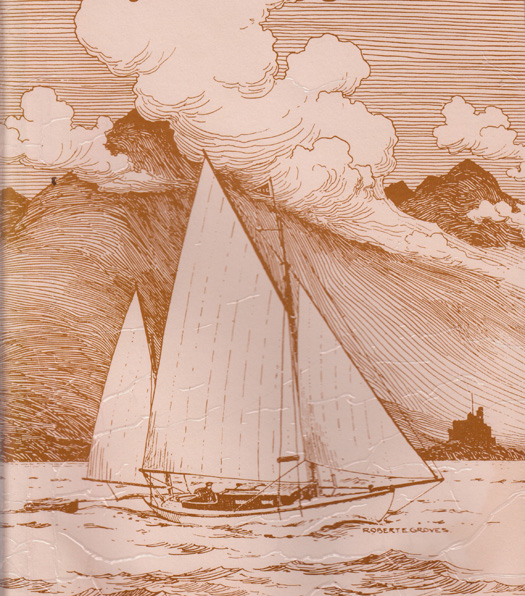
The 25ft Albert Strange-designed gaff yawl Sheila on the West Coast of Scotland in 1909 as sketched by her first owner, marine artist Robert E Groves. Sheila placed second in the Cruiser Class in the Lambay Race of 1921.
Remarkably, both boats still survive, but it is only Sheila which is still in original form. These days she's based on the River Deben in Suffolk on England's East Coast, and as it happens she has just been advertised for sale in prime condition through woodenships.co.uk at £22,000. So if you get your skates on (having won the Lotto), you just have the time to get her to Howth to race again against Ainmara on June 7th.
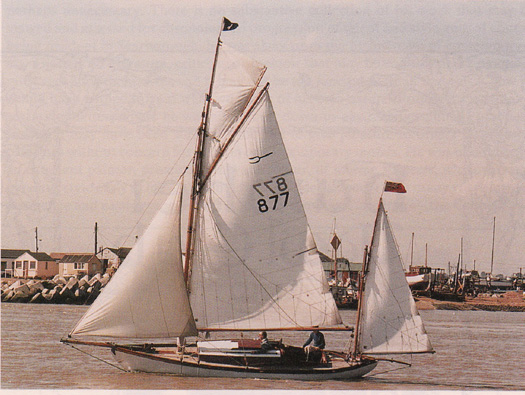
Sheila as she is today in Suffolk, in classic order and for sale at £22,000
Ainmara's hull today is unchanged, but though she was originally noted as a good heavy weather boat with a compact gaff yawl rig and a mainmast only 37ft 6ins long, in the 1930s she was given a massively heavy Bermudan mast. So when owner Dickie Gomes of Strangford Lough was fitting her with an alloy spar which he built himself with the help of specialist friends in the late 1960s, he moved the mast 18ins aft, as John Kearney had originally suggested when he heard – with misgivings – that the change to Bermudan was being made.
Ainmara was in Dublin Bay last year for the inaugural Leinster Plate, so she hopes to be back this year to defend it on May 31st, and then all being well she'll stay on for a week to race again round Lambay on the traditional course on June 7th. To get an idea of how she looked in 1921, this photo of her in 1967 under her first forward-located Bermudan mast is helpful if you can imagine the top third of the Bermudan mainsail removed, and visualise a gaff sail instead, set on a keel-stepped mast whose overall length was only 18 inches longer than the boat's hull LOA of 36ft.

Ainmara in 1967, with the Bermudan mainmast still in the forward position. Try imagining her as gaff rigged, with the mainmast only a little bit longer than the hull. Photo: Denis Pogson
The photo also shows just how very right John B Kearney got his hull lines first time out. Ainmara is one very sweet shape. As Kearney had a fulltime and very demanding job in the engineers department in Dublin Port, his relatively few designs are of special interest, and there's always been particular interest in a design attributed to him from 1924, the 27ft straight-stem yawl Dolphin.
As even a brief study of Kearney designs reveal, he created a distinctive and yacht-like style. The 34ft yawl Sonia, which he designed for, and built with, Bill Blood Smyth in 1929 is essence of Kearney, as we can see from this photo when she was in the ownership of Pierce and Denis Purcell of Dun Laoghaire in the 1940s and '50s.
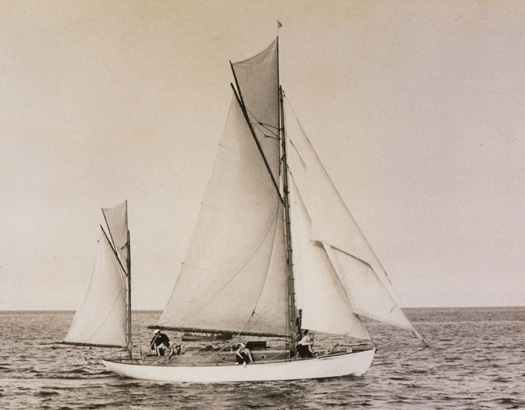
The 34ft 1929 Kearney yawl Sonia (now based in Vancouver) in the ownership of Pierce & Denis Purcell of Dun Laoghaire in the 1940s and '50s, bearing off to oblige the photographer, and showing a remarkably labour-intensive rig with a jib topsail, a topsail on the mizzen, and a topsail on the main. There'd be a mizzen staysail as well, in addition to a spinnaker....... Photo courtesy Pierce Purcell Jnr.
Yet the few written records and folk memories confidently assert that Dolphin is a Kearney design. I can remember her so well from many years around Strangford and Belfast Lough in the ownership of the great Davy Steadman, who once cruised her right round the southern half of Ireland, and then returned as planned through the Shannon and the Grand Canal, no problem as she was shoal daft and had her mainmast in a tabernacle.

Dolphin on Strangford Lough during Davy Steadman's long and happy ownership. Photo: Ann Clementson
The answer to Dolphin's origins came in a real lightbulb moment at the final winter meeting of the DBOGA in Poolbeg Y&BC in March. You never know what's going to come up at these Gaffer gatherings. For instance, I now know in considerable and entertaining detail just why the Castletownbere lifeboat is called the RNLB Annette Hutton, thanks to DBOGA President Tim Magennis having to give us a brilliant impromptu talk when a scheduled speaker failed to show.
At the concluding meeting this Spring, the magic moment came at the end when Cormac Louth suddenly stood up and made an impassioned plea for any memorabilia of any kind at all relating to the fact that between 1818 and the outbreak of the Great War in 1914, there were very strong links between the old fishing community of Ringsend and the great fishing port of Brixham on the south coast of Devon. They were links so strong that today there are many people in Ringsend with Devon surnames, yet there is now virtually no contact between Dublin's most ancient maritime community and the "home port" in southwest England.
It's the sort of nugget of information you squirrel away to examine in detail later. But the lightbulb moment was the sudden realisation that, thanks to the Brixham link, Dolphin might indeed be a John B Kearney design. It's perfectly possible that in 1924 someone asked him to create the plans for a little clinker built cruising yacht whose lines would faithfully reflect the shape of the classic Brixham trawlers, which they'd known in Ringsend for nearly a hundred years.
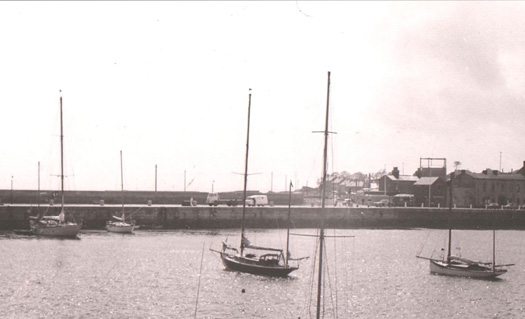
A unique mix of Kearney designs in Donaghadee in 1966. On the left is Perry Greer's 1963-built 54ft Helen of Howth, John Kearney's last and largest design. At mid-harbour is the 36ft Ainmara (1912), his first yacht. And on the right is the 27ft Dolphin (1924), which seems to have been inspired by the classic form of the Brixham trawler. Photo: W M Nixon
Once the Napoleonic Wars ended in 1815, the men of Brixham could start expanding their fishing ambitions, and their increasingly superior boats out-performed most other ports, with the Brixham influence spreading as far east as Ramsgate in Kent, and as far west as Ringsend in Dublin.
With the technological developments accelerated by the World War I, sailing fishing boats were being rapidly replaced by steam and then diesel, but by this time the Brixham vessels had reached an exceptional standard. As big class yachting slowly revived after the war, the regatta circuit made its annual visit to Torquay just across the bay from Brixham. When the skippers of the giant cutters said they couldn't race in the strong winds prevailing as their rigs would become dangerous, the Brixham trawlers contemptuously went forth in full array to show their class, and the Brixham Trawler Regatta came into being.
But with the disruption of the Great War followed by the War of Independence, Ireland's links to Brixham had faded, yet for many in Ringsend, the Brixham trawler remained the ideal, for they were handsome yet able boats. And this gave me another magic moment on a recent Saturday evening in Bridie Keating's pub at Derrynane in far southwest Kerry.
There on the wall, amidst photos of local sailors including Damian Foxall, is an ancient colour photo of the Brixham Trawler Provident. For many years, she was owned by the co-operative known as the Island Cruising Club of Salcombe in Devon, and for most of its members, an annual cruise fetching up in the sublime anchorage of Derrynane, with a spot of conviviality ashore in Bridie's, was what life was all about.
Provident was built in 1924, and so too was Dolphin, and their hull resemblance is startling. Yet it's doubtful if the two boats have ever been together, and it's now unlikely if they ever will be. The last I saw of Dolphin was two years ago in a corner of a little old boatyard near Monkstown on Cork Harbour. Back in 2012, she could maybe have been saved, though only with enormous expense and effort. But it's unlikely that could be done now, yet if she still exists at all, it might be worthwhile to take off her lines.
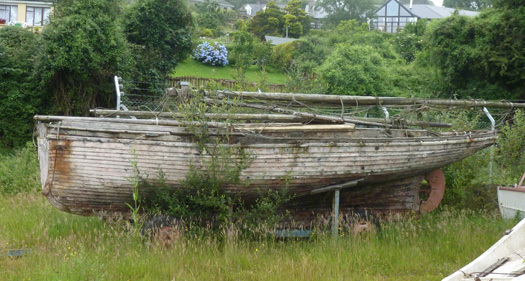
A sad sight. Dolphin in 2012. Photo: W M Nixon

Although clinker construction poses special preservation problems, much of Dolphin's timber seemed in surprisingly good order despite years of exposure and neglect. Photo: W M Nixon
However, the news on the 70ft Provident is good. She's in fine shape after a recent major refit for owners Trinity Sailing Trust, and is based back home in Brixham, the very essence of what a first class Brixham sailing trawler was and is all about.

Provident in all her glory. Owners Trinity Sailing Trust have recently given this historic Brixham-based vessel a complete refit.
Rory Fitzpatrick Wins Howth YC Round of Irish Moth Tour
#moth – Six wins for Rory Fitzpatrick of the National Yacht Club gave him the overall lead in the second round of the Irish Moth tour at Howth Yacht Club at the weekend. The Dubliner discarded a second in the penultimate round of the foiling class to be a clear winner ahead of club mate John Chambers who had three seconds and four thirds in the seven race series (video above). Third was Wexford's Ronan Wallace and fourth the National's Annalise Murphy. Results available to download below.
Two Irish Teams Contest British Team Racing Trophy
#wilsontrophy – Two Irish teams will contest The Wilson Trophy British Open Team Racing Championships are to be held on West Kirby's Marine Lake this weekend (9th – 11th May) and will be hosted by West Kirby Sailing Club (WKSC). Dublin teams from Howth Yacht Club and the Royal St. George YC are travelling to Liverpool for the event now in its 65th year. This unique and spectacular team race sailing event will be welcoming 32 of the finest teams from around the UK, USA and Ireland including three teams from WKSC itself.
Aswell as the Irish participating teams, there will be two Irish umpires at the event. Irish national umpire Cxema Pico is attending and International Judge and national umpire Gordon Davies in also on duty.
The 192 competitors will be sailing in 12-foot dinghies known as Fireflies while under the close observation of some of the best umpires from the UK and overseas. Competition will be fierce this year as some of the traditional teams have disbanded, with sailors joining other teams to try and find that winning formula.
Racing starts at 1pm on Friday 9th May and continues through to late Sunday afternoon. Weather permitting, there will be over 350 fast and cut throat races to watch. The Marine Lake, otherwise known as the 'theatre of dreams', provides a natural amphitheatre where members of the public are encouraged to come and watch the action from the Grandstand on West Kirby promenade (by the old baths). The Visitors Centre and live commentary will also help to explain some of the nuances of the racing to spectators and passers-by.
David Taylor, Commodore of West Kirby Sailing Club, said: "We are thrilled to be hosting this fantastic event, now in its 65th year. It's great to see so many people travelling from near and far to sail on the Marine Lake and enjoy its beautiful surroundings.
"The club is extremely proud to host this event each year and we always aim to provide both the competitors and our local community with a weekend of sporting action that they won't forget."
The three-day event will be an exciting and fun weekend for spectators and competitors alike with a thrilling demonstration of top level sailing, which is free to watch. The final rounds are scheduled to take place on Sunday from 1pm, when the action reaches its climax, with the top eight of 32 teams entering play-offs to take home the celebrated trophy.
The 2014 Wilson Trophy is delighted by the support it has received from many individuals and businesses, including leading sponsors: Carlsberg, Everite Windows, GJW Direct, MI Finance and Speed Medical.
Follow the results at: www.wilsontrophy.co.uk































